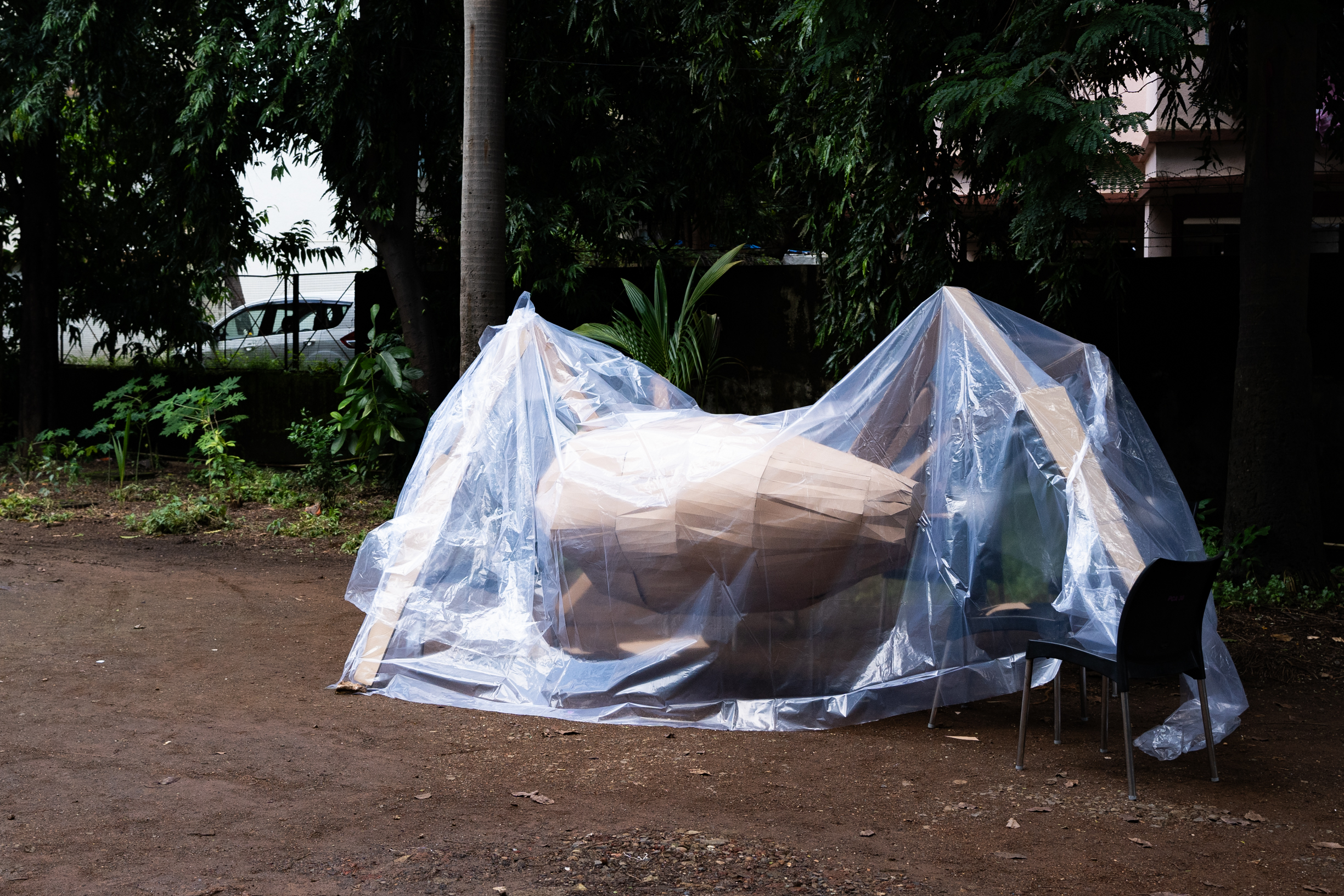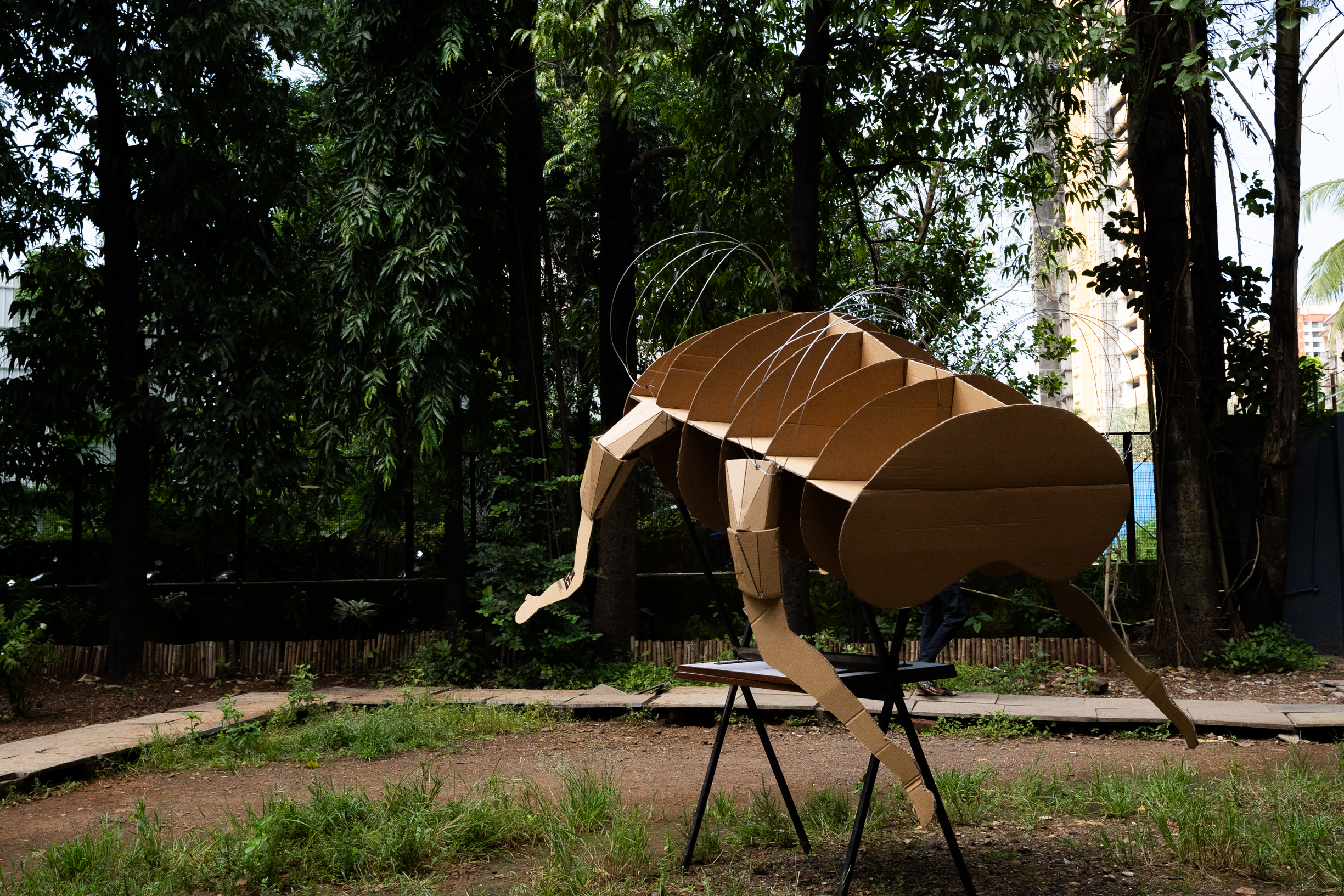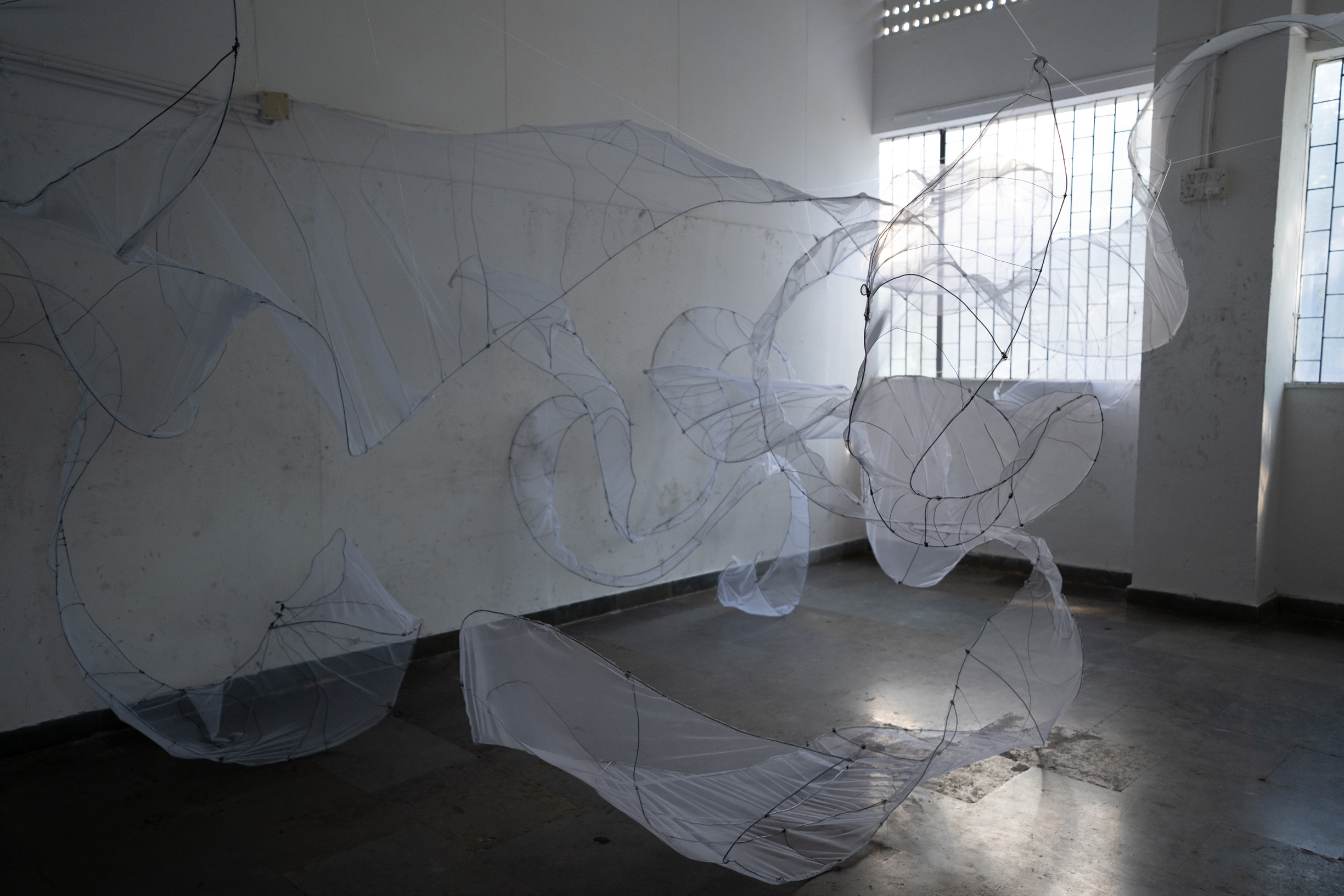Sem 01 / Orientation
Dreaming Forms
Apurva Talpade
The Orientation module has, for the last three years, begun with a text based provocation. The previous year, the poems of Edward Lear, limericks actually, from his The Book of Nonsense were used to open up the idea of the absurd, in order that it could become a launchpad into thinking of drawing and space making that could take us away from habitual ways of imagining form. How does one even begin to think of space or environment when you have, as a drawing and as a reference, the Old Person of Mold, “who suffered from sensations of cold”! However, since the Form and Experience module also begins with a text - where the text is read very closely and several things are drawn out from its reading in order that a thick description of experience might be made, it was decided this year to forgo the reading and begin with something that would be a familiar experience to all, something that all students might have participated in, have had access to; a truly common denominator. More on that very soon.*
Since the previous year’s Orientation module was not archived by this author, the role of the teaching assistants has also not been commented on. The module is dependent in a large way on the assistance of the fifth year students who sign up to be TAs for the two weeks of the course. Their presence has become somewhat crucial for the new students to understand the college, learn basic building and drawing processes, and most importantly, come together as a class and as a part of SEA. The TAs become a cohort to co-teach and guide these students during this time and their work is twofold:
1. To develop drawings with the students where they speak with them, help break down what they already know about drawings and drawing space especially, help them work with a large scale of drawing, think conceptually, draw space and experience, see the drawing as a medium for thinking through and with an idea.
2. In the second week of the course, when they start building and developing spatial forms from the drawings, the TAs are instrumental in organising them primarily, helping them with the ropes of building-making, providing guidance about working out specific details in building, and managing them as a group.
This year, the fifth years signed up in large numbers, 24 of the 37 students from the class participated in the TA programme. This meant that the entire grounds of the campus - the studio on the ground floor as well as the versatile “stilts” where the school eats, collects - was taken over by first year students with reams of newsprint making large charcoal drawings and eventually building with bamboo, wire, netting and various other materials, as well as by the harried fifth year students with their laptops, spending their time being sagacious seniors as well as doing thesis research. The TAs were cheerful, enthusiastic
*The module began with asking students to draw their dreams. The landscapes of dreams are incongruent and absurd spaces, defying the logic of waking reality and opening pathways to unexpected interpretations of the world. They twist familiar environments into surreal terrains, layering memories, desires, and fears into fragmented and fluid forms. These spaces are not bound by linear time or physical constraints; they dissolve and reassemble, evading the stability we rely on. In dreams, movement is both liberated and confounding—sideways, diagonally, and at times spiraling inward—creating a narrative that is nonlinear, elusive, and richly textured.
Since the previous year’s Orientation module was not archived by this author, the role of the teaching assistants has also not been commented on. The module is dependent in a large way on the assistance of the fifth year students who sign up to be TAs for the two weeks of the course. Their presence has become somewhat crucial for the new students to understand the college, learn basic building and drawing processes, and most importantly, come together as a class and as a part of SEA. The TAs become a cohort to co-teach and guide these students during this time and their work is twofold:
1. To develop drawings with the students where they speak with them, help break down what they already know about drawings and drawing space especially, help them work with a large scale of drawing, think conceptually, draw space and experience, see the drawing as a medium for thinking through and with an idea.
2. In the second week of the course, when they start building and developing spatial forms from the drawings, the TAs are instrumental in organising them primarily, helping them with the ropes of building-making, providing guidance about working out specific details in building, and managing them as a group.
This year, the fifth years signed up in large numbers, 24 of the 37 students from the class participated in the TA programme. This meant that the entire grounds of the campus - the studio on the ground floor as well as the versatile “stilts” where the school eats, collects - was taken over by first year students with reams of newsprint making large charcoal drawings and eventually building with bamboo, wire, netting and various other materials, as well as by the harried fifth year students with their laptops, spending their time being sagacious seniors as well as doing thesis research. The TAs were cheerful, enthusiastic
*The module began with asking students to draw their dreams. The landscapes of dreams are incongruent and absurd spaces, defying the logic of waking reality and opening pathways to unexpected interpretations of the world. They twist familiar environments into surreal terrains, layering memories, desires, and fears into fragmented and fluid forms. These spaces are not bound by linear time or physical constraints; they dissolve and reassemble, evading the stability we rely on. In dreams, movement is both liberated and confounding—sideways, diagonally, and at times spiraling inward—creating a narrative that is nonlinear, elusive, and richly textured.
They also give rise to chimeric structures that blend the imagined and the real, constructing architectures that elude definitions. A staircase may ascend to nowhere, while doors open into skies that lead to unexpected memories. These environments resist resolution, allowing for inhabitation that is transient and layered, where the act of dwelling becomes an improvisation. Dreams invite us to inhabit these shifting landscapes not as visitors but as participants in an unfolding dialogue between self, space, and sensation, where the boundaries between interior and exterior dissolve into the uncertain.
Unsurprisingly, the “dream” was interpreted almost immediately as a benign, controlled terrain with comfortable spaces, and their drawings and the accounts that accompanied them became metaphors for cliched and naive aspiration — safe havens or mundane horrors that sidestepped the true strangeness and unpredictability of dreaming. The subject matter of dreams proved slippery; it is not easy to share that which eludes us for the most part and confounds us for the rest, especially with a group of people that are wholly unknown. Dreams demand a confrontation with the uncanny and the deeply personal, asking for a kind of vulnerability that was perhaps an overreach for new students still finding their footing in this collective exercise.
Yet, by bringing their drawings together, by sifting through the layered spaces of fairytales and pushing for more authentic, less sanitized versions of the stories and spaces of their dreams, the larger compositions began to coalesce into something more sincere and rich. The drawings cobbled together spaces that were fragmented yet interconnected, simultaneously intimate and alien. It was from here that they launched into space making exercises. The grotesque fairytale gave forth large insect like creatures that perched at a height above the school grounds; the whirlpool unravelled into these translucent waves that were suspended at varying heights from the opening of the stairwell; a series of arches turned into dense clouds of wire that required you to bend and navigate carefully while passing through; a garden of pieces of what might have been a building was read and made as bits of an everyday life - having parts of plumbing, clothing, utensils, lamps, some as moving parts with counterweights that hung overhead; a drawing of many scales and kinds of stairways became, in a perhaps too-close translation, a complex working out of forms of staired surfaces from a large collection of boxes and thick card; and passing through the forest was seen as a means to inhabit a large and broad corrugated surface by pinching and working it to make sinuous valleys and crests.
These forms were produced as acts of tentative collaboration, but were powerful in how they were able to change the space they took over. For the students, the charge of the module lay in experimenting with drawing as a tool for discovering and imagining space, working closely with a translation process that would hold a spatial charge rather than replicate or model a drawing in three dimensions, and finally at pulling out a kind of truth about dreaming and dreamscapes: their possibilities at being many things that are contrarian, and their capacity to dodge the recognisable. The module asked that the forms produced become more than representations; they were provocations, asking the students to reconsider how space could be imagined, held, and shared. They were fragments of collective imagining that retained the energy and slipperiness of dreaming, embodying its refusal to settle into tidy resolutions while opening up new possibilities for spatial thought and creation.
Unsurprisingly, the “dream” was interpreted almost immediately as a benign, controlled terrain with comfortable spaces, and their drawings and the accounts that accompanied them became metaphors for cliched and naive aspiration — safe havens or mundane horrors that sidestepped the true strangeness and unpredictability of dreaming. The subject matter of dreams proved slippery; it is not easy to share that which eludes us for the most part and confounds us for the rest, especially with a group of people that are wholly unknown. Dreams demand a confrontation with the uncanny and the deeply personal, asking for a kind of vulnerability that was perhaps an overreach for new students still finding their footing in this collective exercise.
Yet, by bringing their drawings together, by sifting through the layered spaces of fairytales and pushing for more authentic, less sanitized versions of the stories and spaces of their dreams, the larger compositions began to coalesce into something more sincere and rich. The drawings cobbled together spaces that were fragmented yet interconnected, simultaneously intimate and alien. It was from here that they launched into space making exercises. The grotesque fairytale gave forth large insect like creatures that perched at a height above the school grounds; the whirlpool unravelled into these translucent waves that were suspended at varying heights from the opening of the stairwell; a series of arches turned into dense clouds of wire that required you to bend and navigate carefully while passing through; a garden of pieces of what might have been a building was read and made as bits of an everyday life - having parts of plumbing, clothing, utensils, lamps, some as moving parts with counterweights that hung overhead; a drawing of many scales and kinds of stairways became, in a perhaps too-close translation, a complex working out of forms of staired surfaces from a large collection of boxes and thick card; and passing through the forest was seen as a means to inhabit a large and broad corrugated surface by pinching and working it to make sinuous valleys and crests.
These forms were produced as acts of tentative collaboration, but were powerful in how they were able to change the space they took over. For the students, the charge of the module lay in experimenting with drawing as a tool for discovering and imagining space, working closely with a translation process that would hold a spatial charge rather than replicate or model a drawing in three dimensions, and finally at pulling out a kind of truth about dreaming and dreamscapes: their possibilities at being many things that are contrarian, and their capacity to dodge the recognisable. The module asked that the forms produced become more than representations; they were provocations, asking the students to reconsider how space could be imagined, held, and shared. They were fragments of collective imagining that retained the energy and slipperiness of dreaming, embodying its refusal to settle into tidy resolutions while opening up new possibilities for spatial thought and creation.










